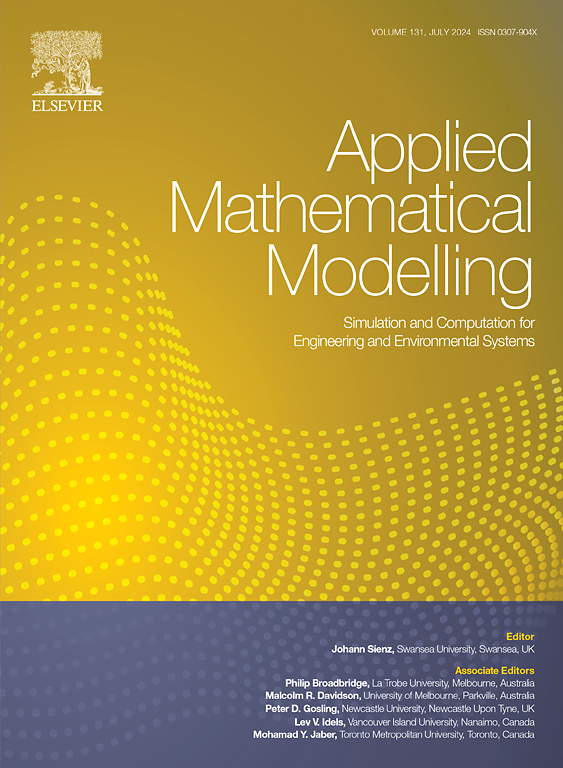用于高精度宽带振动声学响应分析的动态刚度分析公式
IF 4.4
2区 工程技术
Q1 ENGINEERING, MULTIDISCIPLINARY
引用次数: 0
摘要
本文介绍了一种分析建模技术,它将动态刚度法(DSM)与频谱 DSM(SDSM)相结合,用于宽带二维振动声学响应分析。该方法采用 DSM 对梁进行建模,其精确解法专为一般声学或分布力激励而设计。同时,声腔采用 SDSM 建模,边界条件由快速收敛的修正傅里叶级数描述。梁腔界面的振声耦合是通过法向速度连续性条件来实现的,从而产生了一个具有简明分析表达式的显式耦合矩阵。这确保了对结构-声耦合效应更直接、准确和有效的表述。波束和声腔元素都是直接组合而成的,用于模拟复杂的振动-声学系统,而不需要在结构域或声学域进行额外的元素离散化。因此,该方法只需要很少的自由度(DoF),同时在预测宽带振动声学行为方面保持了很高的精度。值得注意的是,所提出的方法只使用了 0.06% 的自由度和 0.2% 的计算时间,却达到了与有限元软件包 COMSOL 相当的精度。这些优势凸显了该方法作为各种振动声学问题基准工具的潜力。本文章由计算机程序翻译,如有差异,请以英文原文为准。
An analytical dynamic stiffness formulation for highly accurate broadband vibro-acoustic response analysis
An analytical modelling technique is presented that integrates the dynamic stiffness method (DSM) with spectral DSM (SDSM) for broadband 2D vibro-acoustic response analysis. The method employs DSM to model beams with exact solutions specifically designed for general acoustic or distributed force excitations. Meanwhile, acoustic cavities are modelled using SDSM, where boundary conditions are described by the rapidly converging modified Fourier series. The vibro-acoustic coupling at beam-cavity interfaces is enforced via the normal velocity continuity condition, resulting in an explicitly formulated coupling matrix with concise analytical expressions. This ensures a more direct, accurate, and efficient representation of the structural-acoustic coupling effect. Both beam and acoustic cavity elements are assembled directly to model complex vibro-acoustic systems, without requiring extra element discretization in either the structural or acoustic domains. As a result, the method requires very few degrees of freedom (DoFs) while maintaining high accuracy in predicting broadband vibro-acoustic behaviour. Notably, the proposed approach achieves comparable accuracy to the finite element package COMSOL while using only 0.06% of the DoFs and 0.2% of the computational time. These advantages highlight the method's potential as a benchmark tool for various vibro-acoustic problems.
求助全文
通过发布文献求助,成功后即可免费获取论文全文。
去求助
来源期刊

Applied Mathematical Modelling
数学-工程:综合
CiteScore
9.80
自引率
8.00%
发文量
508
审稿时长
43 days
期刊介绍:
Applied Mathematical Modelling focuses on research related to the mathematical modelling of engineering and environmental processes, manufacturing, and industrial systems. A significant emerging area of research activity involves multiphysics processes, and contributions in this area are particularly encouraged.
This influential publication covers a wide spectrum of subjects including heat transfer, fluid mechanics, CFD, and transport phenomena; solid mechanics and mechanics of metals; electromagnets and MHD; reliability modelling and system optimization; finite volume, finite element, and boundary element procedures; modelling of inventory, industrial, manufacturing and logistics systems for viable decision making; civil engineering systems and structures; mineral and energy resources; relevant software engineering issues associated with CAD and CAE; and materials and metallurgical engineering.
Applied Mathematical Modelling is primarily interested in papers developing increased insights into real-world problems through novel mathematical modelling, novel applications or a combination of these. Papers employing existing numerical techniques must demonstrate sufficient novelty in the solution of practical problems. Papers on fuzzy logic in decision-making or purely financial mathematics are normally not considered. Research on fractional differential equations, bifurcation, and numerical methods needs to include practical examples. Population dynamics must solve realistic scenarios. Papers in the area of logistics and business modelling should demonstrate meaningful managerial insight. Submissions with no real-world application will not be considered.
 求助内容:
求助内容: 应助结果提醒方式:
应助结果提醒方式:


